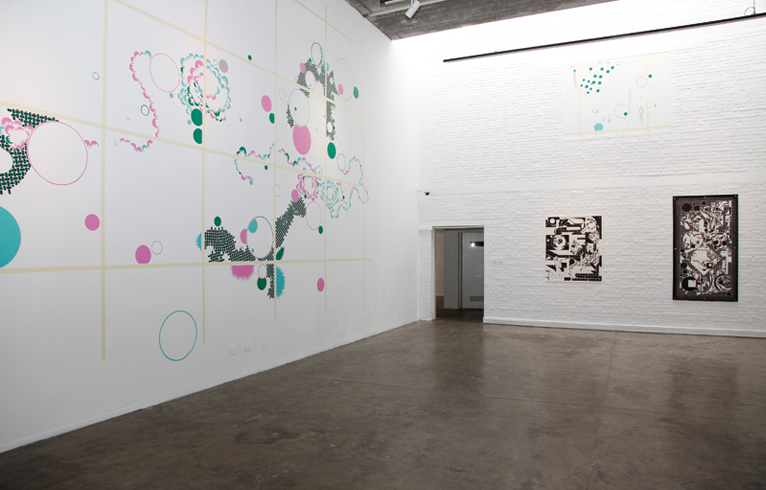WENG WEI: CHASING SITES
| December 29, 2011 | Post In LEAP 11

“Chasing Sites” was a relatively sedate presentation for artist Weng Wei, focusing on her ink paintings on rectangles of paper and cutouts affixed to clearly delimited sections of the gallery walls. These new works and their installation in Pékin Fine Arts have calmed the spontaneity of her earlier appearances, and this aspect of spontaneity— instigated in part by the precarious conditions under which she was then working— she now treats with some ambivalence. This show has become a critique of those conditions, with the new works as close readings of past installations, rationalizations of the things which she looked for from those venues but which she feels were lacking.
Drawn from her memories of those situations, these paintings seem to visualize some of the physical and mental conditions under which she was working. The paintings themselves are in dense black ink on heavy paper, with crisp outlines but including the occasional representation of a brushed edge. The overall impression is very strong, although what these forms represent remains ambiguous. At times, elements can be discerned. There are some recognizable architectural spaces in isometric or perspective projections— the regular forms of art-fair booths in SmileAngel Foundation, CIGE 2011 (2011), and the small gallery space of Slice at Arrow Factory Space, Beijing (2010). There also occur representations of the iconic shapes that have consistently appeared in her work, including those of her paper cut-outs that here lose their freestanding nature to become graphic forms on paper, or to be attached to the gallery walls. The blurring of boundaries between the forms of the cut-outs and the artist’s paper weavings, a feature of past installations, here has become another of the symbols in these new works. (Full disclosure: one of the pieces, Anti-mapping at CPU:798, Beijing takes the artist’s project at the author’s now-defunct space as its raw material.)
Whereas these shapes, elements and events have all previously inhabited a narrative universe defined by the artist, that aspect is now not raised; they appear to stand alone or to simply serve as pointers back to their original settings, whereby they can reconnect with the literary symbolic function within the artist’s worldview. Ideally, these texts and stories would survive in the background of the work, for as allegorical elements they energize the work, and add a surreal depth to its meaning. In the current show it seems as if the previous settings and gallery sites have taken over to command this allegorical energy, as many, no longer existent, have slipped into their own histories, thus providing a legacy of suitable fictions for the artist to build upon.
It will be interesting to see Pékin Fine Arts’ own contribution to this legacy. One might suggest that the wall drawings that the artist has layered throughout the gallery spaces represent this. These additions are the only colored drawings in the show, but rely on a limited palette of pink, gray, dark green, and turquoise. A loose grid of yellow strips mark out parts of the drawings— similar to the weavings mentioned before but on such a large grid they are almost architectural— and of the structure off which the circles, weavings and shapes then launch themselves and work against.
In Weng Wei’s work the most interesting moments come when the artist’s library of symbols and meanings come back into contact with the world (or a world)— as narrative, installation, performance, or, as here, a far more controlled set of renditions of the past and present. This show appears to be a valuable taking stock for the artist, but here’s to hoping that future incursions of her vision will take place in less organized surroundings. Though perhaps uncomfortable for the artist, it should provide her with the friction necessary for her elements to react and thrive. Edward Sanderson

